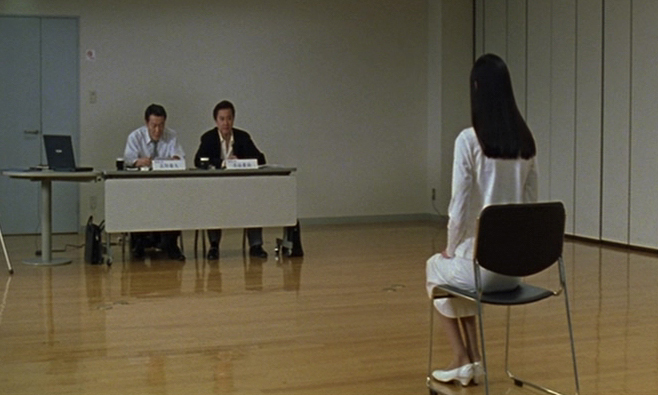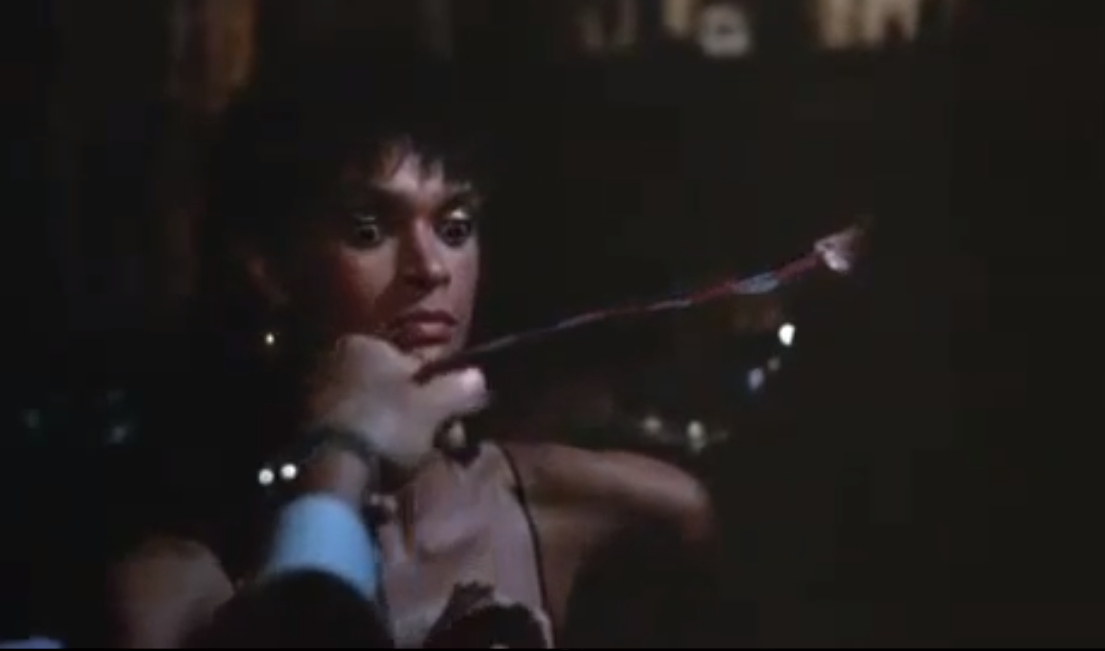In his recent post on Audition, Bert Stabler points out that the film is essentially a rape-revenge genre story. And yet, something isn’t quite right. Normally, we should experience the humiliation (and the sadistic pleasure) of the rape first, and then experiencing the sadistic pleasure (and the humiliation) of the revenge. That is the the inevitable, brutal, giddy fulcrum of narrative works. Conflict/resolution; crime/justice; brutality/counter-brutality; rape-revenge. It is the engine of plot stripped down to a crude, pointed bone.
In Audition, as I said, this simple axis of event goes awry. The front half of the film is essentially a romantic-comedy buildup — evoking a different, and perhaps uncomfortably analogous narrative simplicity. Aoyama (Ryo Ishibashi) , a producer and widower devastated by the loss of his wife, decides, at the urging of his son, to find a girlfriend. A director friend offers to hold a false film audition so that Aoyama can pick/ask out the most appealing of the actresses. Aoyama chooses a striking young ballet dancer, Asami (Eihi Shiina), who reciprocates his interest.
Only towards the film’s end does the rape start to coalesce, not as event but as disjointed image and memory. Our friendly middle-aged protagonist Aoyama learns (or imagines?) that his lover, Asami , was brutally tortured by her middle-aged dance instructor, and that she cut off his feet in revenge. Eventually, in what may be a dream, Asami cuts off Aoyama’s foot, linking him to her brutalizer. Essentially, rape and revenge occur simultaneously, or apparently simultaneously. The punishment calls forth the crime, or identifies the criminal. The narrative doesn’t drive the film so much as appear frozen and flickering at the end, a slowly strobing cascade of horror and violence playing ambiguously in the interstices of a supposedly more innocent life. Former audition and later exploitation merge; the film’s second half infects its first, and both intentionally implicate the director as manipulator of rape, revenge, and narrative. Indeed, with sequence broken, character starts to come apart as well, the filmmaker merges not just with Aoyama and his skeevy evaluation of female pulchritude, but with Asami and her gleeful vivisection. Scopophilia and sadism burst out of their narrative bonds to revel in frozen tableau — abjection freed from the facade of justice.
The 1984 Clint Eastwood film Tightrope has an oddly similar trajectory. Here too, a rape-revenge narrative wanders vaguely off its well-marked track. Police detective Wes Block (Eastwood) is, like Aoyama, a single dad (divorced, in his case) who loves his children (daughters, here)…but who also has an unpleasant side. Block frequents prostitutes, and seems to have a general inability to keep his dick in his pants. This complicates things considerably, since Block is pursuing a mysterious killer who rapes and murders prostitutes. The killer starts to follow Block and murder the prostitutes he sleeps with, and finally we learn that he (the killer) was once a cop himself.
Block and the killer, then, are insistently linked and doubled — and the film clearly flirts with the idea that it is Block himself who is the murderer. The murderer uses handcuffs on his victims; Block, too, has a thing for handcuffs in bed. The murderer likes to use ribbons for strangulation. Block…uses his tie.
When Block’s daughter (played by Eastwood’s real-life daughter) is raped by the killer, it becomes, paradoxically and queasily both the rape and the revenge — it is the trauma which punishes Block for the same trauma that he (the killer) has inflicted.
So, just as in Audition, the confusion of the rape/revenge is tied to a blurring or scrambling of characters. And also as in Audition, the complication or confusion of that narrative tends to create a fetishistic stillness. In Tightrope, this occurs not through dream-like images, but instead through repetitive focus on significant objects. The killer is identified again and again by a slow pan down to his shoes; his trademark red ribbons appear repetitively at different crime scenes; and of course because the killer is following the cop and the cop is following the killer, locations and characters repeat themselves with more ominous meaning (and music) as the film circles around and around itself in a slow twisting effort to catch its own tail.
Tightrope ultimately turns its back on its art film impulses and scurries back to the safety of being a Hollywood piece of shit, complete with dunderheaded final chase scene and Block heroically redeemed by fisticuffs and a good woman, not necessarily in that order. But before that happens, it, like Audition, exchanges the brutal rush of narrative for the immobile despair of, as Bert puts it, “endless defeat.” In these films, rape and trauma are not so much crimes that can be punished as stains that you stare at, day in and day out, till you can’t tell the nice guys from the sinners, nor violation from revenge.



